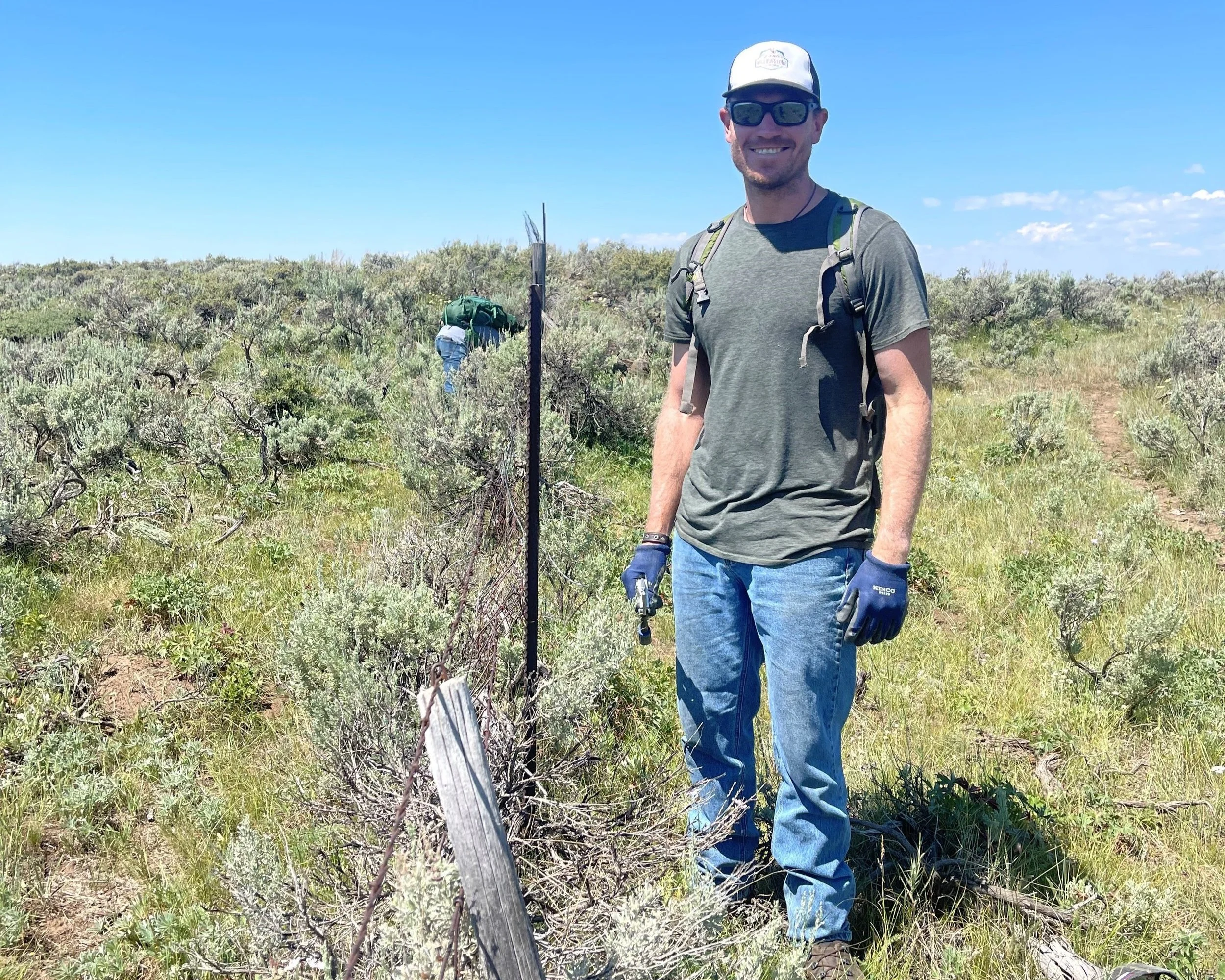GYC and partners retrofit fencing in Sand Creek Desert to support vital wildlife migrations
Driving north from St. Anthony, Idaho, the landscape transitions from the mosaic of agricultural lands to a vast expanse of sagebrush, interspersed with the ever-changing complex of sand dunes. Arriving at a predetermined GPS waypoint, my coworker, Allison Michalski and I meet up with Tim Swearingen, an Idaho Fish and Game Biologist. After jumping in his truck and navigating a maze of ranch roads and gates, we arrive at the project site approximately 60 miles west of Yellowstone and Grand Teton National Parks. The sheep fence stretches out to the west, situated amongst volcanic rock outcrops and semi-arid plant species. Sagebrush has grown into the woven sheep wire of the fence, a testament to the age and lifespan of these human-made barriers. Grabbing wire cutters and loppers, we begin our short hike to the project zone.
The sage-brush landscape of the Sand Creek Desert. (Photo GYC/Allison Michalski)
At first glance, it is hard to draw connections between the undulating sagebrush flats of the Sand Creek Desert and the high peaks of the Centennial Mountains or robust wildlife populations of Yellowstone National Park. Lesser-known and seemingly far removed from other areas of the Greater Yellowstone Ecosystem, the Sand Creek Desert is a stark contrast to its neighboring lands. This ecosystem, however, plays a significant role in providing crucial winter range for ungulate species, such as elk, moose, and mule deer, that spend their summers in the neighboring mountain ranges and national parks.
Approximately 300 moose, 4,400 elk, and 3,800 mule deer navigate a myriad of obstructions along their migration corridors between winter and summer ranges, encountering busy highways, agricultural development, fencing, and increased levels of recreation. The Greater Yellowstone Coalition has partnered with numerous state and federal agencies, conservation organizations, and private landowners to address the issue of wildlife connectivity, with the goal of removing impassable sheep fencing that will increase permeability for migrating wildlife within the Sand Creek Desert region.
This summer, GYC partnered with Idaho Fish and Game (IDFG), the Bureau of Land Management (BLM), Idaho Department of Lands (IDL) the U.S. Fish and Wildlife Service, Backcountry Hunters and Anglers (BHA), and the Natural Resources Conservation Service (NRCS) on a collaborative fence removal and retrofit effort.
An illustration of a let down fence, making movement and migration easier for Greater Yellowstone’s wildlife. (Illustration Bill Gamradt; Credit Rocky Mountain Elk Foundation)
Within the greater Sand Creek Desert, IDFG identified a 5.8-mile section of fencing on IDL and BLM lands that created a significant barrier to wildlife passage. This fence is constructed of a top strand of barbed wire, along with an impenetrable section of woven sheep wire that severely inhibits any ungulate movement. Upon removal, a new wildlife-friendly, letdown fence with smooth wire will be installed using some of the remaining fence posts. This new fencing will benefit ranchers and wildlife populations alike, as it can be let down during certain times of the year when ungulates are moving across the landscape and cattle are not present, and reinstalled when cattle are put back out to graze.
Western Wyoming Consevation Assocation Teddy Collins works on a fence to make it more permeable for Greater Yellowstone’s wildlife to pass through. (Photo GYC/Allison Michalski)
These projects are possible because of effective stakeholder collaboration between state and federal agencies, conservation organizations, and private landowners. Because of the fragmented land management and ownership within the Sand Creek Desert, cooperation between diverse stakeholders is critical in order to move the needle forward with future projects and achieve meaningful conservation gains in the ecosystem.
Wildlife-friendly fencing is one step within a holistic approach to protecting ungulate migrations throughout the Greater Yellowstone Ecosystem. Providing safe highway crossings and the management of increased recreation demands on the landscape are additional measures that must be addressed in order to mitigate dangers and preserve the incredible movements of our iconic wildlife species within the region. We are grateful for the partners who made this project possible and donors who continue to support this important work! If you know of a troublesome fence that needs replacing, or you would like to replace the barbed wire fences on your property with a better option for our Greater Yellowstone wildlife, please contact me at tcollins@greateryellowstone.org.
-Teddy Collins, Western Wyoming Conservation Associate
The Greater Yellowstone Ecosystem is the land of 30+ Indigenous Tribes who maintain current and ancestral connections to the lands, waters, wildlife, plants, and more.




